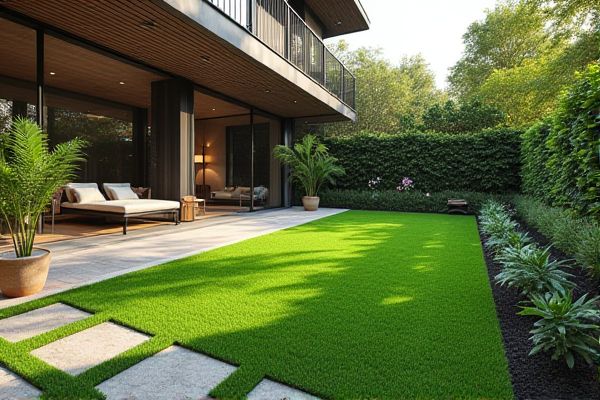
Synthetic grass offers a low-maintenance, green alternative that stays lush year-round without watering or mowing, while pavers provide a durable, versatile surface ideal for patios and walkways with easy customization options. Explore the full article to discover which option best suits Your landscaping needs and lifestyle preferences.
Table of Comparison
| Feature | Synthetic Grass | Pavers |
|---|---|---|
| Installation | Quick, minimal labor | Labor-intensive, requires base preparation |
| Maintenance | Low - no watering or mowing | Medium - periodic cleaning, weed control |
| Durability | 10-20 years, UV resistant | 20+ years, weather and load resistant |
| Cost | Moderate upfront, low upkeep | Higher upfront, moderate upkeep |
| Appearance | Realistic green turf look | Variety of textures and colors |
| Drainage | Good, with proper base | Excellent, permeable options available |
| Environmental Impact | Non-biodegradable, water-saving | Natural materials, can affect soil permeability |
| Comfort | Soft, cushioned surface | Hard, less comfortable |
Introduction: Comparing Synthetic Grass and Pavers
Synthetic grass offers a low-maintenance, green aesthetic year-round, making it ideal for areas with limited natural sunlight or water restrictions. Pavers provide durable, customizable surfaces that enhance outdoor functionality and design versatility for walkways, patios, and driveways. Evaluating your outdoor space needs helps determine whether synthetic grass or pavers better balance appearance, durability, and maintenance requirements.
Aesthetic Appeal: Visual Differences
Synthetic grass offers a lush, vibrant green appearance year-round that mimics the look of natural turf, enhancing outdoor spaces with a consistent and low-maintenance aesthetic. Pavers provide a more structured and polished look, available in various shapes, colors, and textures that create distinct patterns and complement modern or traditional landscaping styles. The choice between synthetic grass and pavers significantly impacts the visual dynamics of a yard, balancing natural softness with architectural precision.
Installation Process and Time
Synthetic grass installation typically requires preparing the ground, laying a weed barrier, and securing the turf with infill, which can be completed in one to three days depending on area size. Paver installation involves excavating, leveling the base, laying sand or cement, placing the pavers individually, and sealing the joints, often taking several days to a week due to complexity. Synthetic grass offers a quicker and less labor-intensive installation compared to the meticulous and time-consuming process of laying pavers.
Cost Comparison: Upfront and Long-Term
Synthetic grass typically involves higher upfront costs ranging from $8 to $15 per square foot, but offers low maintenance expenses over time, potentially saving homeowners thousands in water bills and lawn care. Pavers generally cost between $10 and $20 per square foot initially and may require periodic maintenance and repairs, increasing long-term expenses. When comparing long-term investment, synthetic grass provides consistent cost savings due to reduced upkeep, while pavers might incur escalating costs associated with cleaning, sealing, and replacement.
Durability and Lifespan
Synthetic grass offers exceptional durability with a lifespan of 15 to 25 years, resisting wear from heavy foot traffic and harsh weather conditions without fading or cracking. Pavers provide long-lasting strength, often exceeding 30 years, and can be easily replaced if damaged, but they may suffer from cracking due to freeze-thaw cycles and shifting soil. Choosing between synthetic grass and pavers depends on your need for maintenance-free, flexible surfaces versus hardscape with high load-bearing capacity.
Maintenance Requirements
Synthetic grass requires minimal maintenance, including occasional brushing to keep fibers upright and periodic cleaning to remove debris or pet waste. Pavers demand more upkeep, such as regular sweeping, weed control between joints, and resealing to prevent stains and weather damage. Both options offer durability, but synthetic grass significantly reduces time and effort spent on maintenance compared to pavers.
Environmental Impact
Synthetic grass reduces water consumption significantly compared to traditional lawns, making it an eco-friendly alternative in drought-prone areas. Pavers, while durable, often require impervious materials that increase runoff and contribute to urban heat islands, negatively affecting local ecosystems. Choosing synthetic grass can minimize your environmental footprint by conserving water and reducing heat absorption in your outdoor space.
Usability and Comfort
Synthetic grass offers a soft, cushioned surface ideal for barefoot walking, children's play areas, and pet-friendly zones, enhancing overall comfort and safety. Pavers, while durable and low-maintenance, provide a firm, uneven surface that can become hot under direct sunlight and may cause discomfort for prolonged standing or walking. Usability of synthetic grass excels in recreational and aesthetic applications, whereas pavers suit high-traffic zones requiring stability and structural support.
Weather Resistance and Performance
Synthetic grass offers superior weather resistance by maintaining its color and texture through intense sun exposure, heavy rain, and freezing temperatures without cracking or fading. Pavers, while durable, can experience shifting or cracking in extreme weather conditions, especially with freeze-thaw cycles, leading to potential maintenance issues. Your choice between synthetic grass and pavers depends on the balance of low maintenance and consistent aesthetic performance in varying climates.
Best Applications and Recommendations
Synthetic grass excels in residential yards, playgrounds, and sports fields where low maintenance and year-round greenery are desired. Pavers are ideal for driveways, patios, and walkways that require durability, high load-bearing capacity, and design flexibility. For high-traffic areas or regions with variable weather, combining synthetic grass with pavers offers an optimal balance of aesthetics and functionality.
 homyna.com
homyna.com